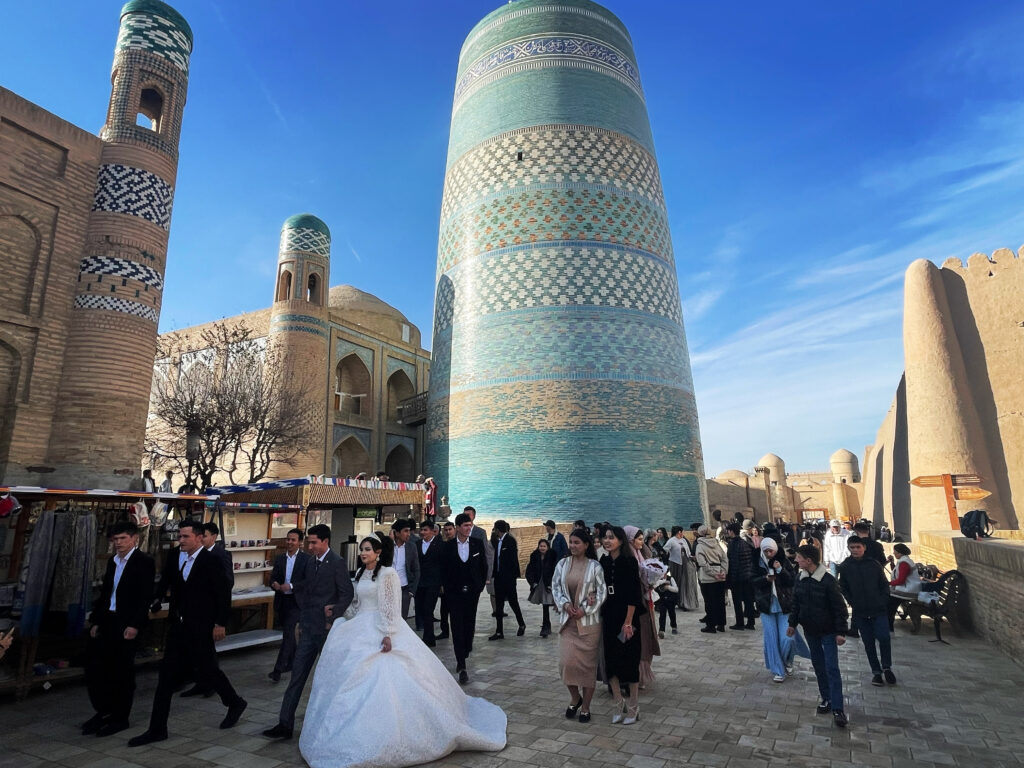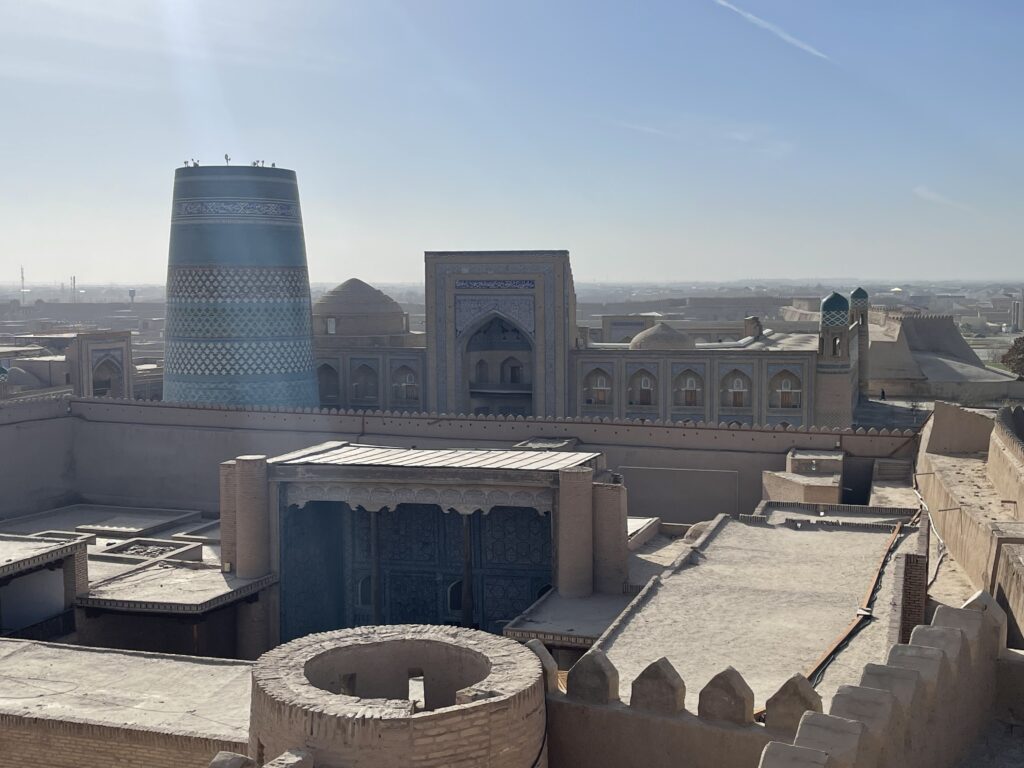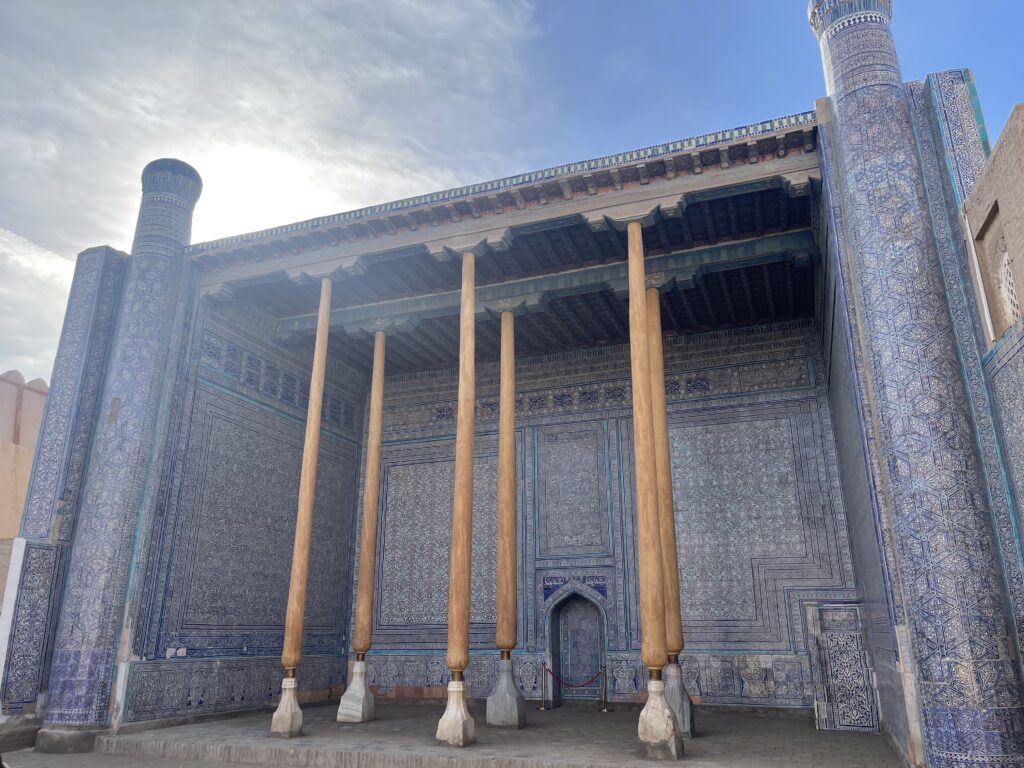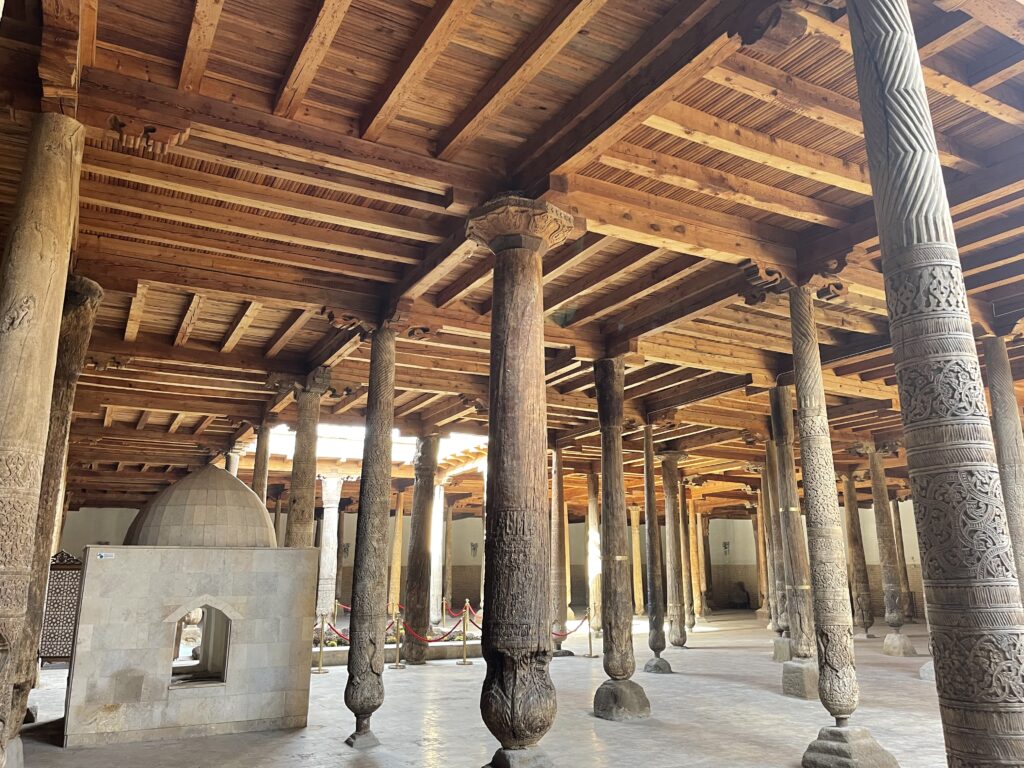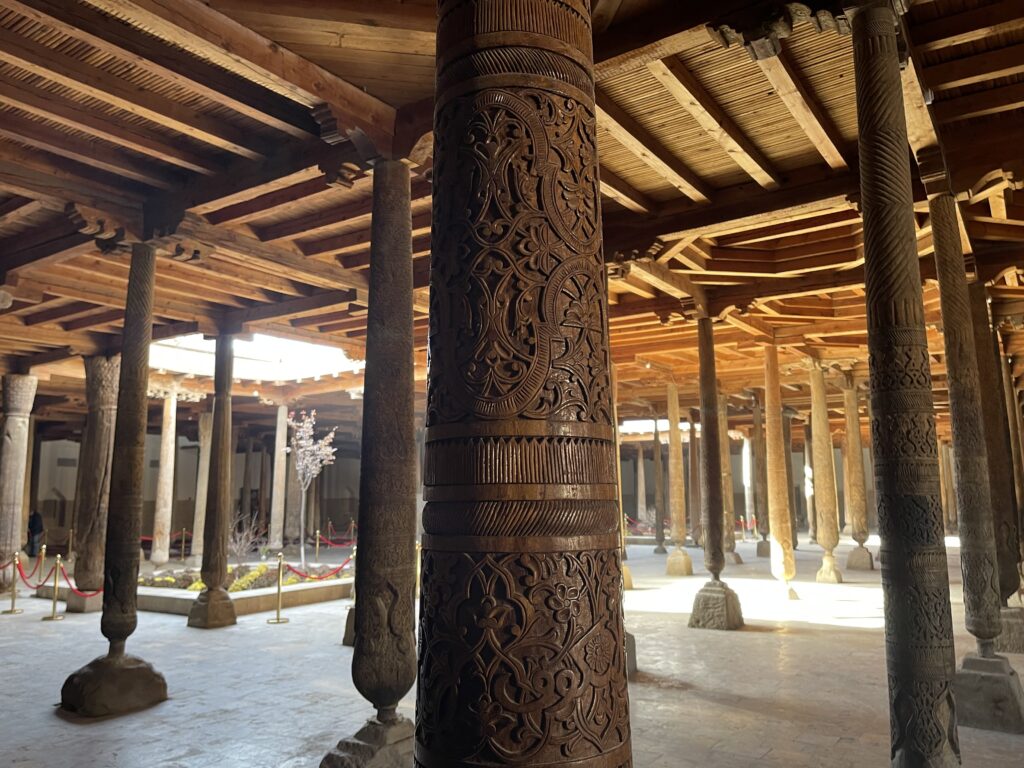The Silk Road city of Khiva in Uzbekistan is claimed to be more than 2,500 years old and is one of the country’s most popular tourist destinations.
Often likened to an ‘open air museum’, Khiva’s old city Itchan Kala is a labyrinth of over 50 unique and magnificent mosques, madrassas, minarets, and mausoleums.
These architectural wonders are safeguarded by fortress walls towering up to 10 meters high and 6 meters thick, giving the city the feel of a grand citadel from ancient tales.
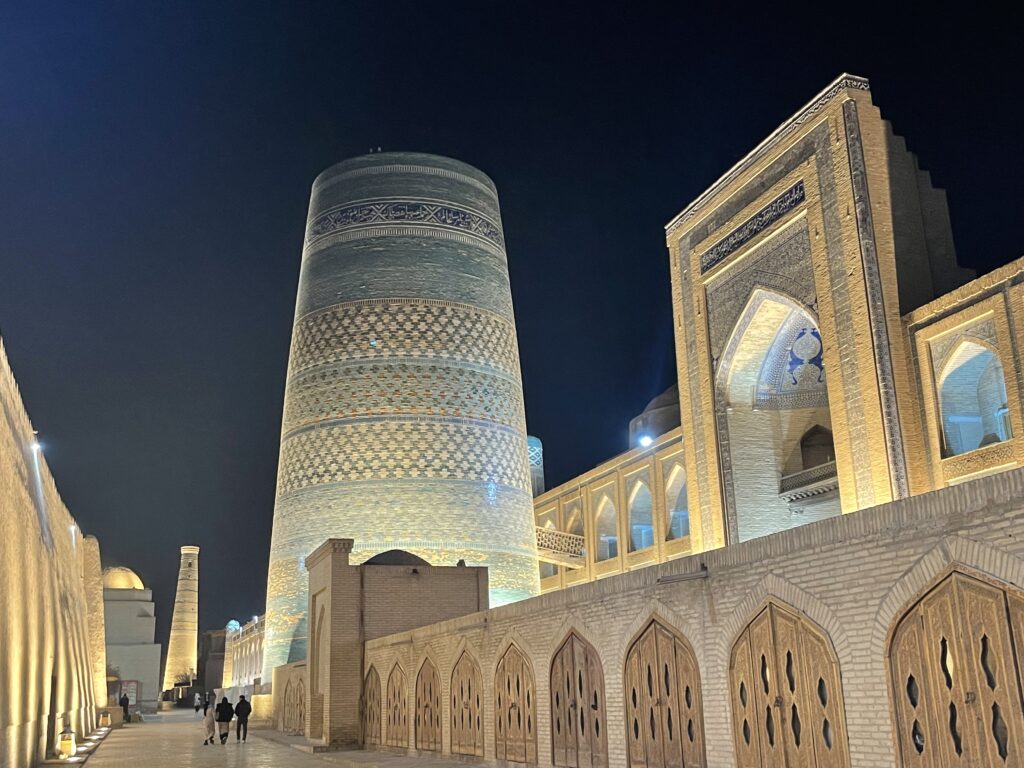
If you’ve ever wanted to step back in time to a mystical medieval era then Khiva is the place to visit. Passing through the majestic gates of the city feels like stepping through a portal to a medieval fortress, showcasing a range of architecture that spans centuries.
Itchan Kala is a world UNESCO heritage site and was also given the title of the ‘tourist capital of the Islamic world’ for 2024.
If you’re considering visiting then you’re in the right place. We live in Uzbekistan and in this Khiva travel guide we’ll tell you everything you need to know about visiting this historical city.
Disclaimer: This blog post may contain affiliate links. If you make a purchase through these links, I may earn a commission at no extra cost to you. Your support is greatly appreciated and helps me continue to provide valuable content. Thank you!
History of Khiva
Although its exact historical origin is not known, archeologists have found evidence that Khiva has been around since at least the 6th century CE. Legend has it that Khiva was founded by Shem, the son of the Bible’s Noah, as he dug a well and exclaimed “heyvak” upon tasting the refreshing water.
Once an ancient Zoroastrian site, the city transformed into an Islamic center following its conquest by the Arabs in the early 8th century. Ravaged by Genghis Khan in the 13th century, it later came under the governance of the Khiva Khanate in the early 16th century, retaining this rule until 1920. The majority of Khiva’s monuments hail from the era of the Khanate’s rule spanning several centuries.
The city has a dark history of slave trade from the 17th to the 19th centuries in which hundreds of thousands of Persians were thought to have been captured and sold as well as a smaller number of Russians.
These days the old town is home to hundreds of locals, many of whom work in crafts or the tourism industry.
Itchan Kala
Itchan Kala, also written as Ichan Qala in Uzbek, refers to the inner fortress of Khiva. This ancient town is believed to be over 2,000 years old, encompassing 26 hectares surrounded by more than 2 km of fortress walls.
Designated as a UNESCO World Heritage Site, Itchan Kala is home to the majority of Khiva’s tourist attractions.
Things to Do in Khiva
Kalta Minor Minaret
The Kalta Minor Minaret is arguably Khiva’s most iconic monument. Situated near the West gate, the city’s largest entrance, this turquoise minaret is hard to overlook, standing at a height of 29m with a base diameter of 14.5m.
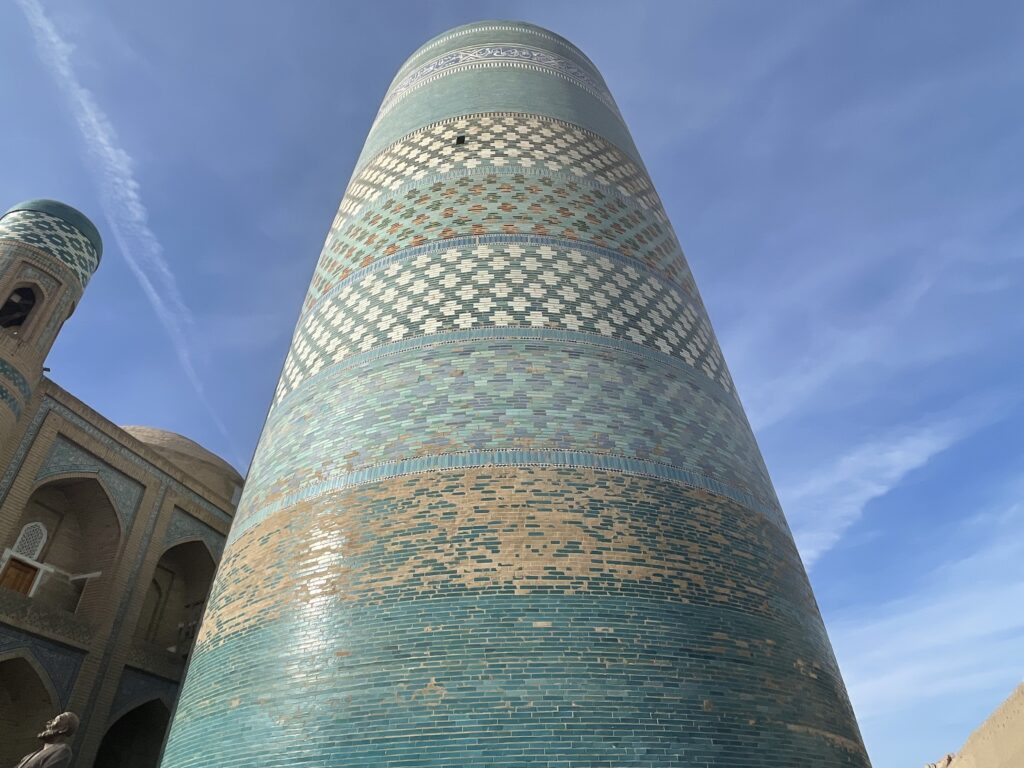
Despite its height it was actually originally planned to be at least 70m high by ruler Muhammad Amin Khan. It is said that he aspired to see Bukhara from the top of the tower (which would be some achievement considering the 200 km distance!).
There are two theories for why it was never completed. One theory is that the Khan had given an order to kill the architect, having learned that he had agreed to build a similar minaret for the emir of Bukhara. Upon hearing this the architect fled, leaving the tower unfinished.
The other theory is that the construction of the minaret was simply stopped as the Khan was killed by the Turkmens in 1855 as their plans to conquer Southern Turkmenistan failed.
You can’t go up the minaret unfortunately but it makes for great photography and can be viewed from many of the old town’s rooftops. It’s especially photogenic at sunset.
Kunya Ark Fortress
Erected at the end of the 17th century by Arang Khan building upon its foundations believed to date from the 5th century, the Kunya Ark is an integral part of Itchan Kala.
Initially constructed as a residence and fortress for the Khan, it evolved into a “fortress within a fortress”, including offices, a mint, summer and winter mosques, a harem, an armory, kitchen, stable, prison, and even an area for fighting rams.
The Iranians caused significant destruction to the Kunya Ark in the 18th century, but Iltezer Khan led its restoration at the beginning of the 19th century. This period largely defines the appearance of what stands today.
One of the highlights of the Kunya Ark is the watch tower which gives one of the best views of the city. Built on the West side of the city to look out for Turkmen tribes, the stairs to the watchtower are fairly steep but worth the climb for the view.
Mohammed Amin Khan Madrassah
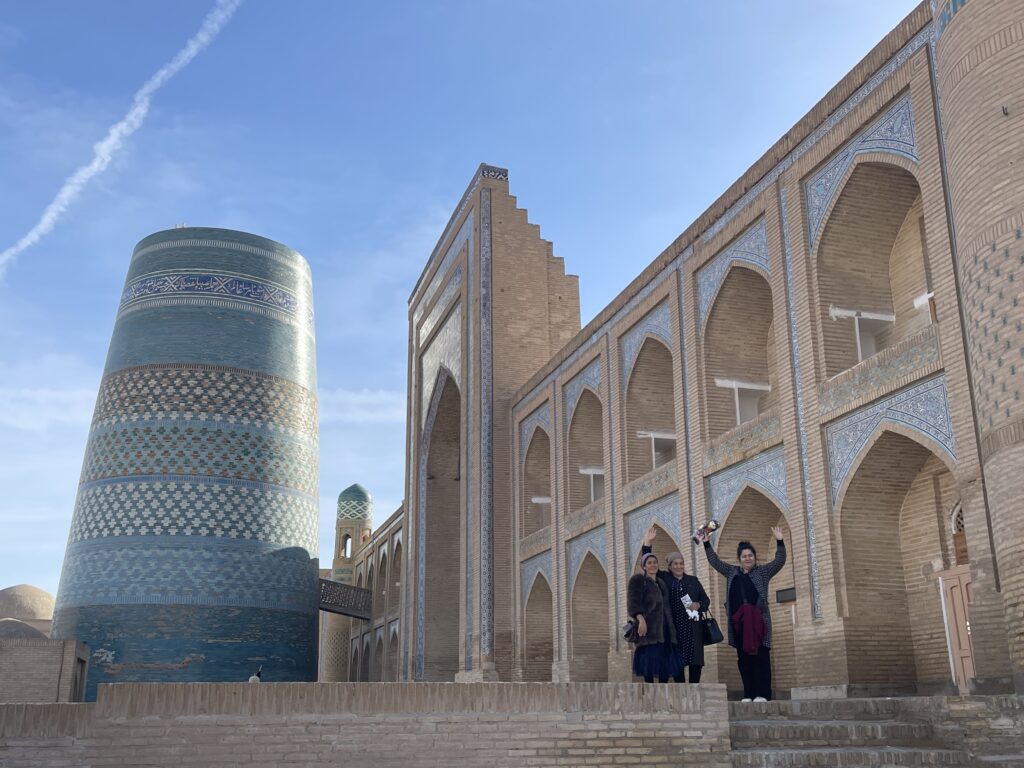
Completed in 1854, this Islamic school was one of the largest in Central Asia, featuring 125 khudjras (cells) intended to house 260 students.
Located right beside the Kalta Minor Minaret, the madrassah is now home to Orient Star hotel open to the public. Here, you can experience an authentic stay in the heart of Khiva’s Itchan Kala site.
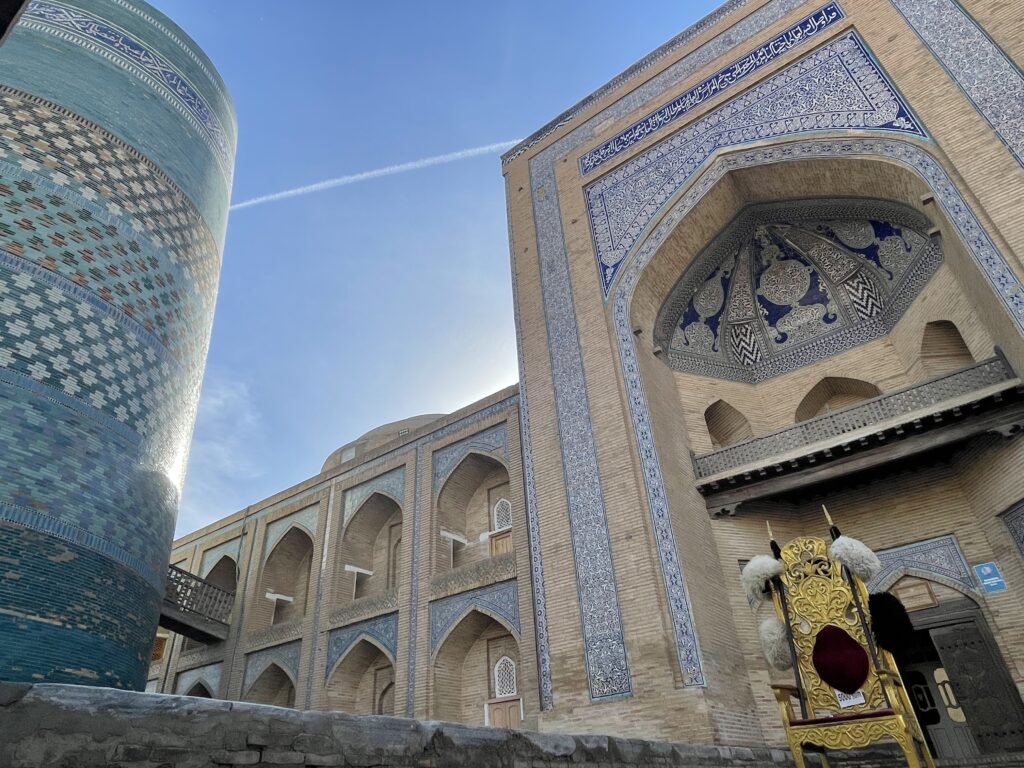
The second floor rooms, each boasting a balcony with wooden doors and turquoise-tiled arched roofs, allow you to savor the charm of Khiva from the comfort of your own room.
Islam Khoja Complex
The Islam Khoja Minaret, finished in 1908 and standing at 45 meters tall, is Khiva’s largest minaret and a revered symbol of the city.
Built by Islam Khoja, the Grand Vizier (Prime Minister) of the Khiva Khanate, the minaret’s turquoise-topped structure can be climbed for an additional cost of 100,000 Som. This climb, especially enjoyable just before sunset, provides a perfect bird’s-eye view over the city.
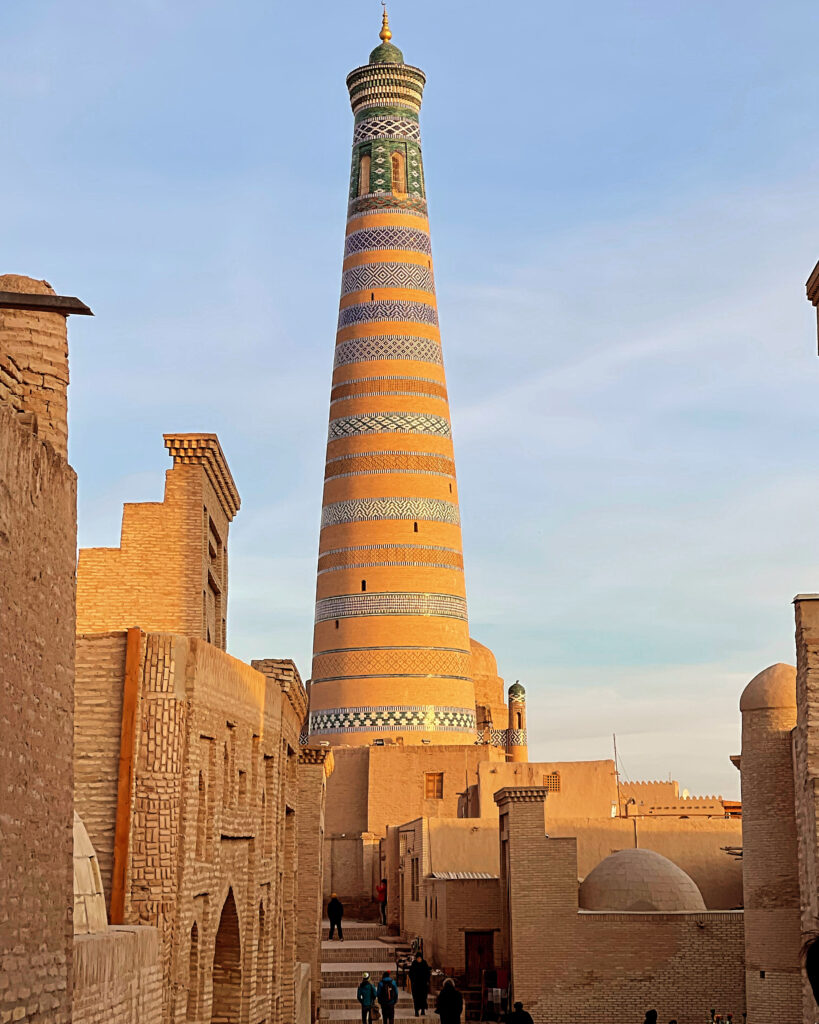
The attached Islam Khoja Madrassah contains 42 rooms built as living spaces for students and today the madrassah functions as the Khorezm Applied Museum with over 400 exhibits including wood carvings, textiles, and jewelry some dating as far back as the 14th century.
Juma Mosque and Minaret
The Juma Mosque is a particularly unique building. Whereas Uzbekistan’s mosques typically have intricately designed entrances, turquoise domes, and courtyards, the Juma Mosque has none of these.
Instead what makes the Juma Mosque unique is its 212 hand carved wooden columns holding up its wooden ceiling. Some of the wooden columns and doors are hundreds of years old, dating back as far as 1316.
The interior of the mosque is eerily dark and resembles some kind of enchanted forest. The openings in the roof add extra atmosphere, causing the sun’s rays to form mystical-like beams across the hall.
Entrance to the Juma Mosque is included in the premium ticket but to climb the attached Juma minaret has an additional fee.
The Mausoleum of Pahlavan Mahmud
The Mausoleum of Pahlavan Mahmud has a particularly beautiful interior, turning the most amateur photographer into a professional!
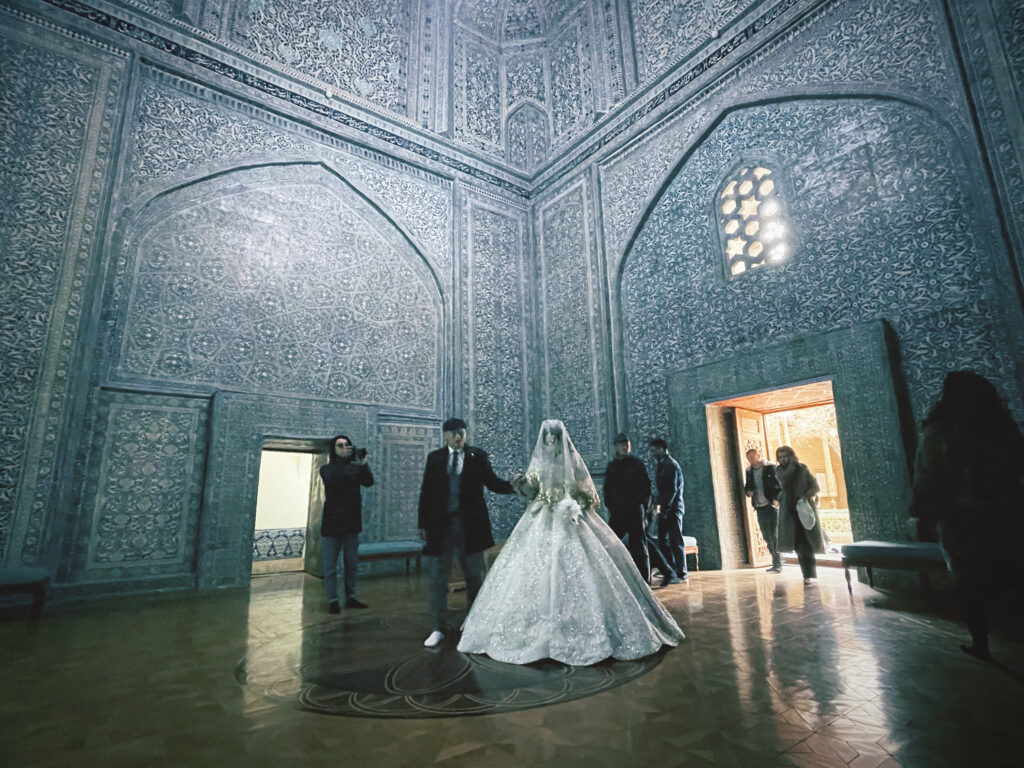
The mausoleum holds the tomb of Pahlavan Mahmud, a poet and philosopher who was perhaps better known for being a professional wrestler. Mahmud was something of a local hero, becoming the patron saint of Khiva after his death in 1326.
The original mausoleum was said to be modest in design but it has been drastically altered over the centuries and is now a place of pilgrimage, identifiable from the outside by its large azure dome.
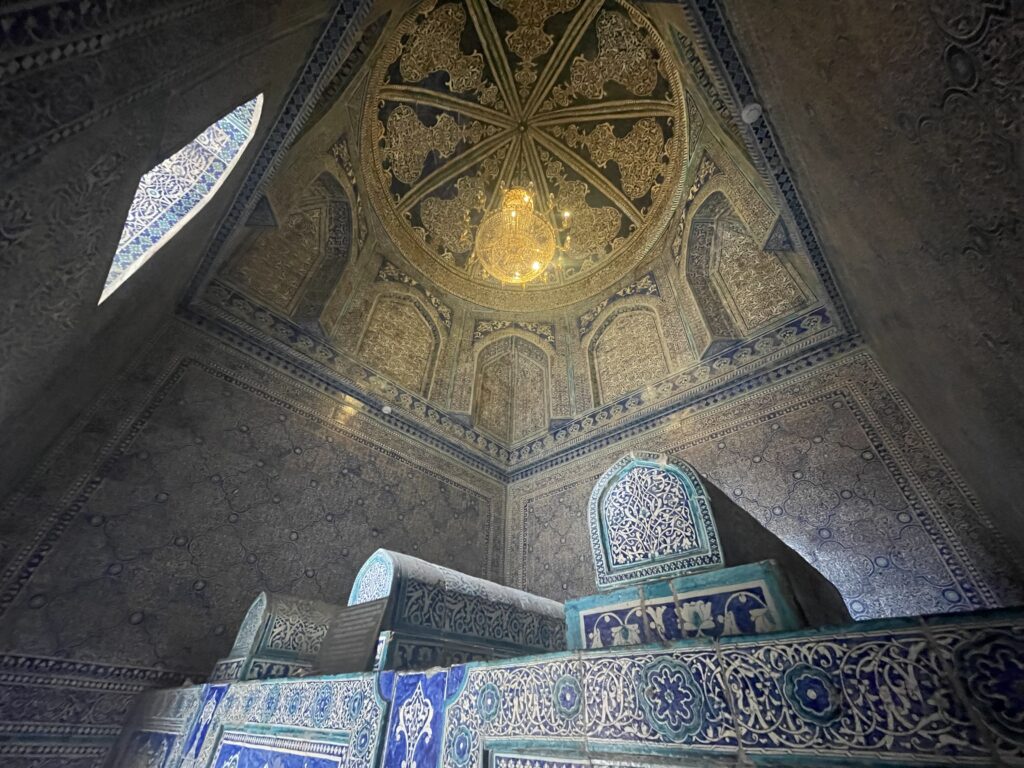
The room containing his tomb is one of the most sober parts of the whole city with locals coming here to pray. Guests may take photos but must take off their shoes to enter.
Entrance to this mausoleum is not included in the ticket price and costs an additional 25,000 Som which is well worth the price just for the photo opportunities alone.
Tosh Hovli Palace
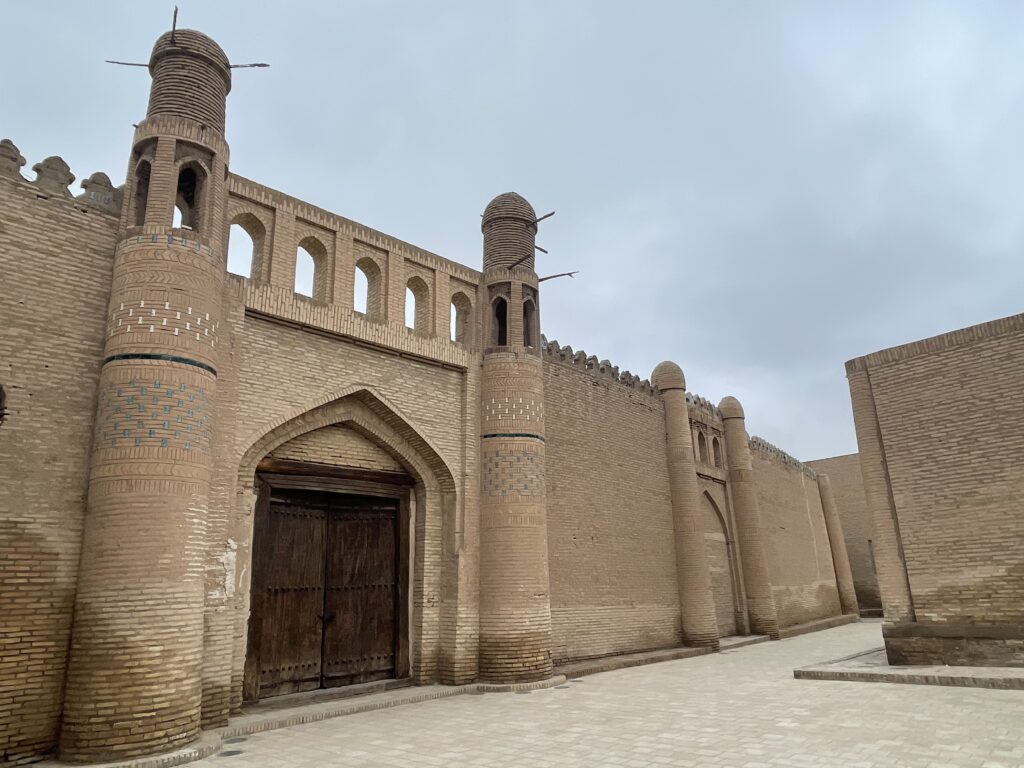
The Tosh Hovli Palace is a mini maze of corridors, small rooms and tiny doors leading to large courtyards. Meaning ‘stone house’, Tosh Hovli Palace was the main living quarters of the Khivan Khans built by the Khan of Khiva between 1829 and 1839.

There are two separate areas you can visit each with their own entrance. The North wing of the palace is one single large courtyard with rooms for the Khan’s four wives on the left and his harem on the right.
The South wing of the palace is where the confusing layout will have you wandering in and out of tiny doors and into unexpected courtyards. Take your time visiting the palace as it’s a fascinating building to stroll around.
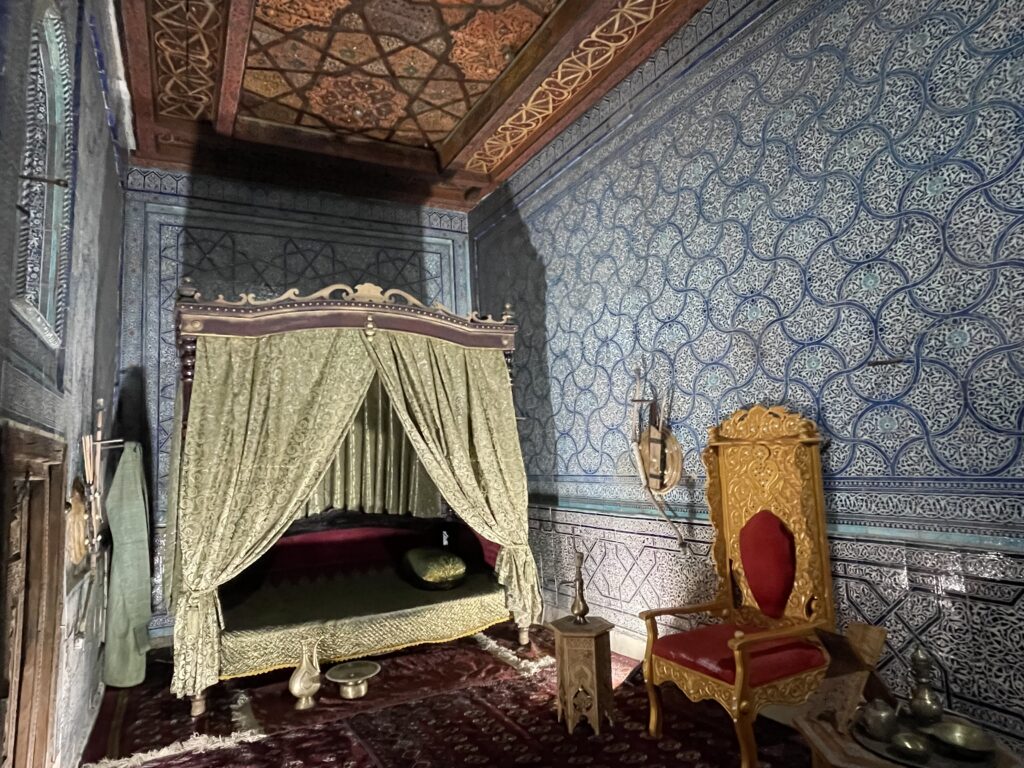
Nurullaboy Palace (Isfandiyar Palace)
Nurullaboy Palace is located outside the Itchan Kala walls, just a few minutes walk from the North gate. It is a relatively modern palace having been built between 1896 and 1904 by Muhammad Rakhimkhan II for his son Isfandiyar.
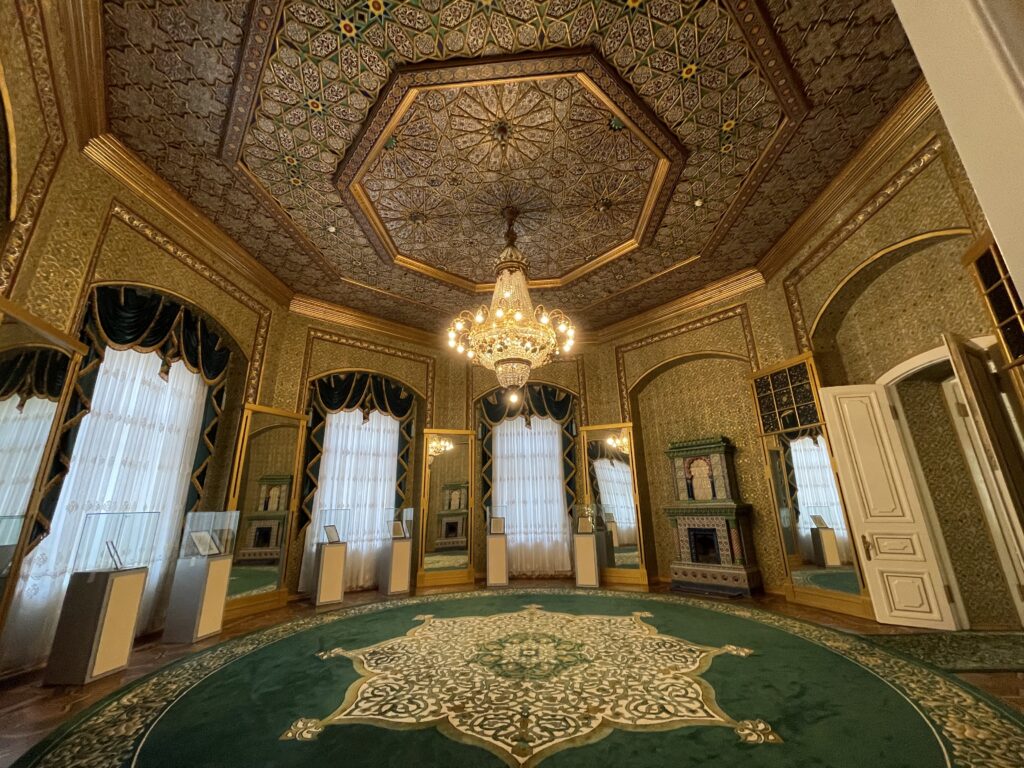
As space for new buildings inside Itchan Kala was limited, it is said that the Khan bought the garden from wealthy local merchant Nurullabay with the promise to keep the name of the garden.
The palace is particularly impressive inside, showcasing an eclectic mix of Asian and European styles with porcelain vases from China, Russian porcelain dishes, and German furniture. It’s worth a visit just for the wallpaper alone!
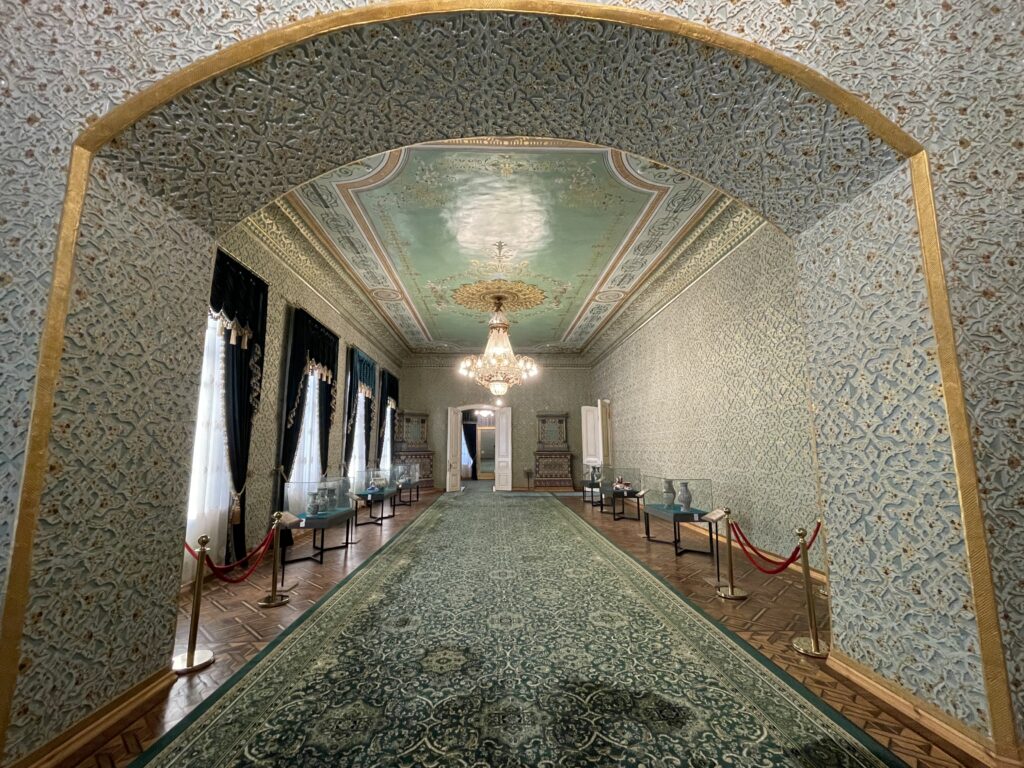
The palace doesn’t receive many visitors and is a wonderful place for photos. I was the only tourist in the whole grounds at the time of my visit, making the walk around the palace eerily silent. I’d go as far as to say the palace was my favorite place to visit in Khiva for its almost spooky ambience.
Entry to the palace is 50,000 som (it’s not included in the Itchan Kala ticket price).
Visit Itchan Kala at Night
Khiva’s old town is also home to many local residents and as such the gates of the city never close. Even after the mosques and museums close you can still explore the city at night, offering a totally different experience of the city.
Many of the monuments are lit at night making for some excellent photography opportunities or just a leisurely walk around the illuminated landmarks.
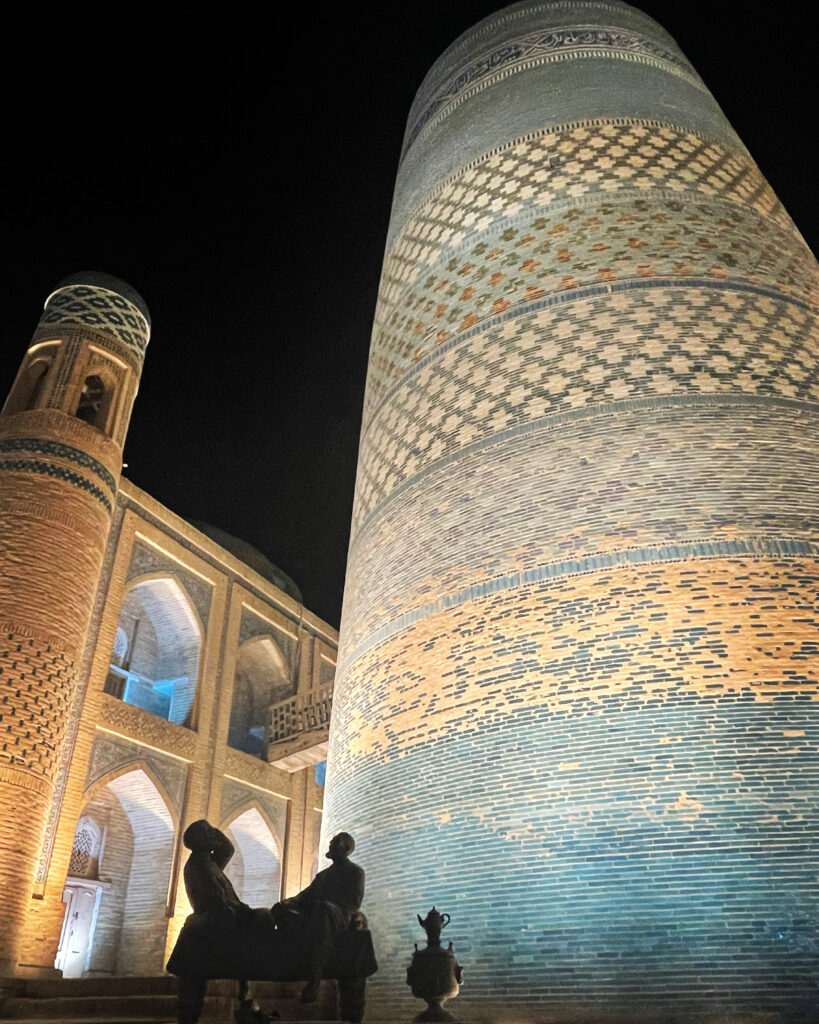

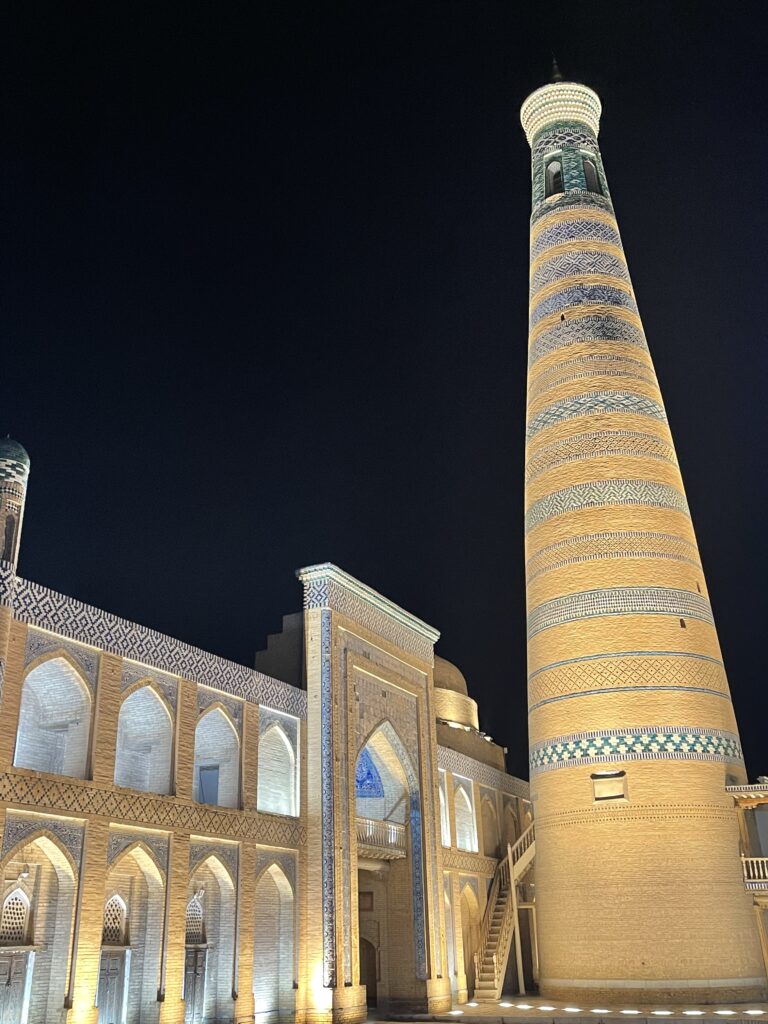
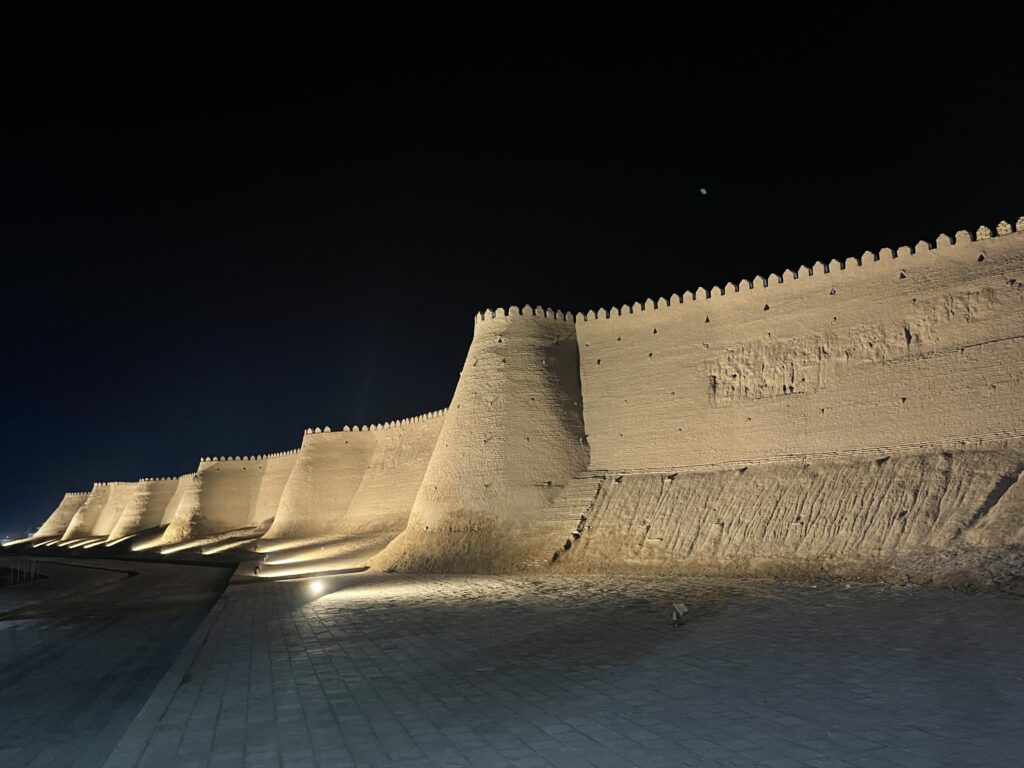
Explore the Itchan Kala Walls
Although the wall has been damaged and rebuilt multiple times, a section of the wall is still walkable. There is a stretch of wall from the watchtower of Kunya Ark Fortress to Tosh Hovli Palace which has an intact path which can be explored for an additional fee of 20,000 Som.
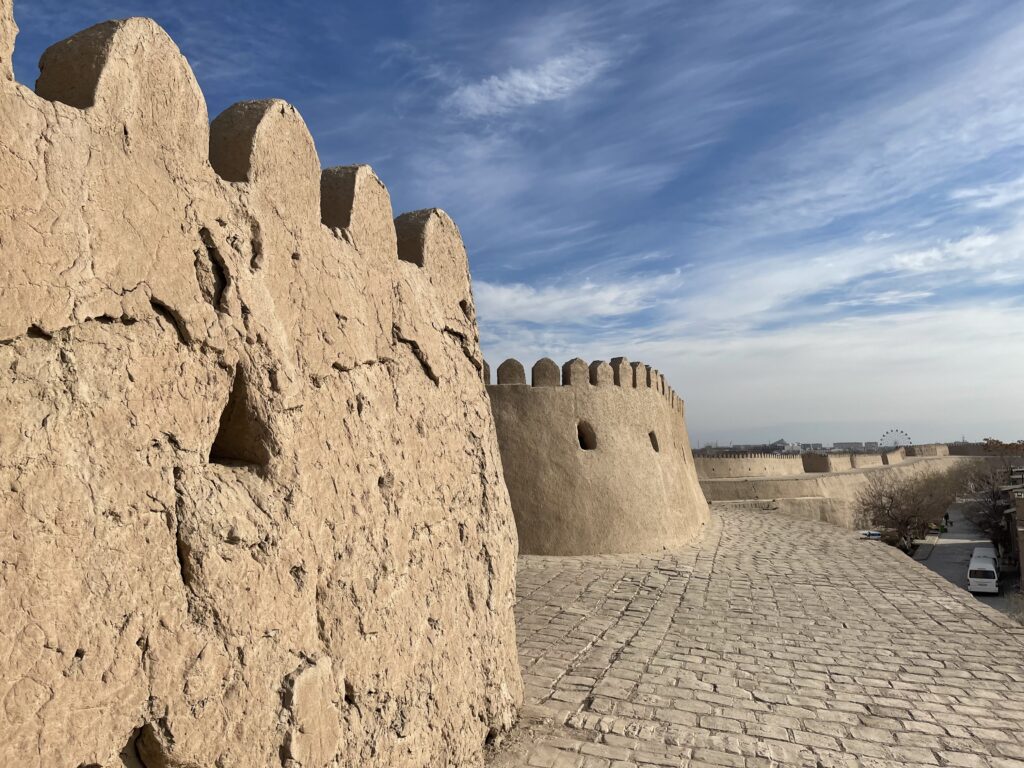
It’s not the best place to view the city from since most of this area consists of hotels and dwellings for locals but it’s a good experience if you want to explore the fortress walls and their observation corners.
To climb the walls you need to find the guard who will unlock the gate to the steps. It’s not suitable for all as there’s no rail to hold and the steps are fairly steep.
Where to Stay in Khiva
For most tourists, the best place to stay in Khiva is inside the Itchan Kala walls. From here you’re only a short walk away from virtually all of the city’s tourist attractions, hotels, and restaurants.
Khiva has plenty of affordable hotels and most of them are family-owned boutique style guest houses located in and around the old city.
There are a large number of highly-rated hotels inside the Itchan Kala walls, allowing you to experience the city day and night for the most immersive experience.
Best Hotels in Khiva
Some of the best hotels in Itchan Kala are:
Siyovush Hotel

Conveniently located next to the Islam Khoja Minaret, this family-run hotel has some fantastic views from its balconies. Staff are exceptionally helpful and attentive and will go out of their way to help you.
Rooms are clean and spacious, and the whole hotel is elegantly decorated with traditional Uzbek rugs, wooden columns, and wooden ceilings. It’s one of the very highest rated hotels in Khiva.
Ulli Oy Hotel & Terasse
Modern family hotel just a 2-minute walk from Kalta Minor. Although the staff don’t speak much English, they will certainly take care of you. The entire hotel has been recently renovated, maintaining its classic charm while enhancing its modern amenities.
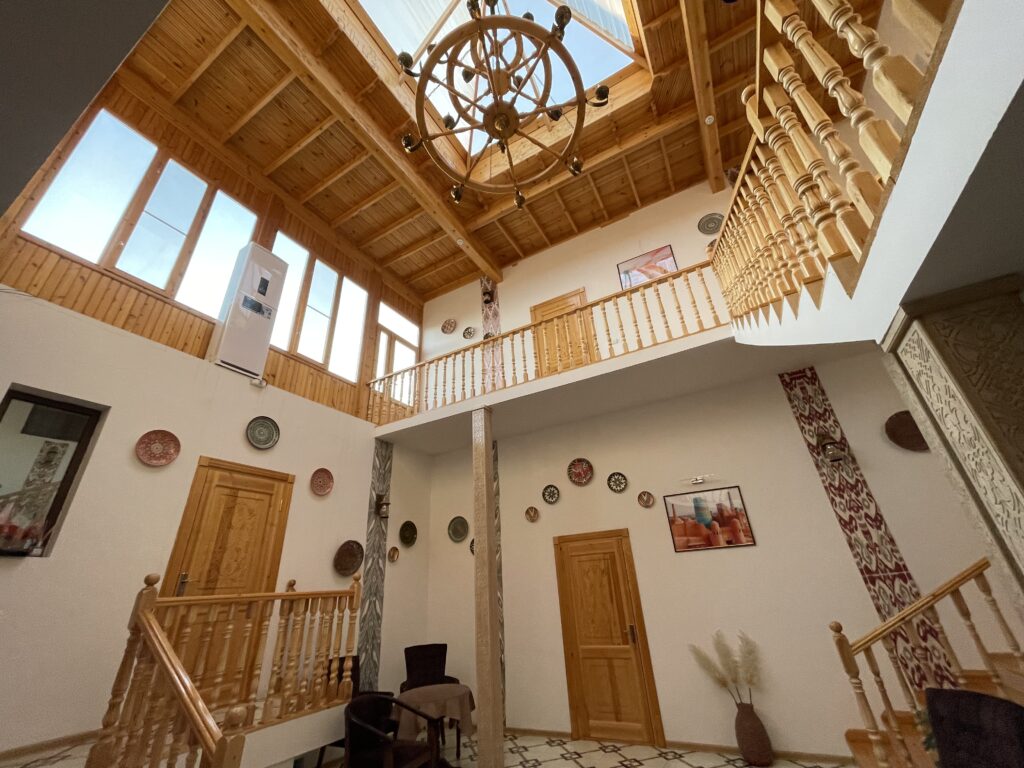
I stayed here for one night and recommend it for its location and fancy interior. Go to breakfast with an empty stomach as host Dilya will make sure you’re well fed!
Polvon-Qori Boutique Hotel
Another one of Khiva’s highest-rated hotels, Polvon Qori is a hotel inside a beautiful converted madrassah with its own minaret!
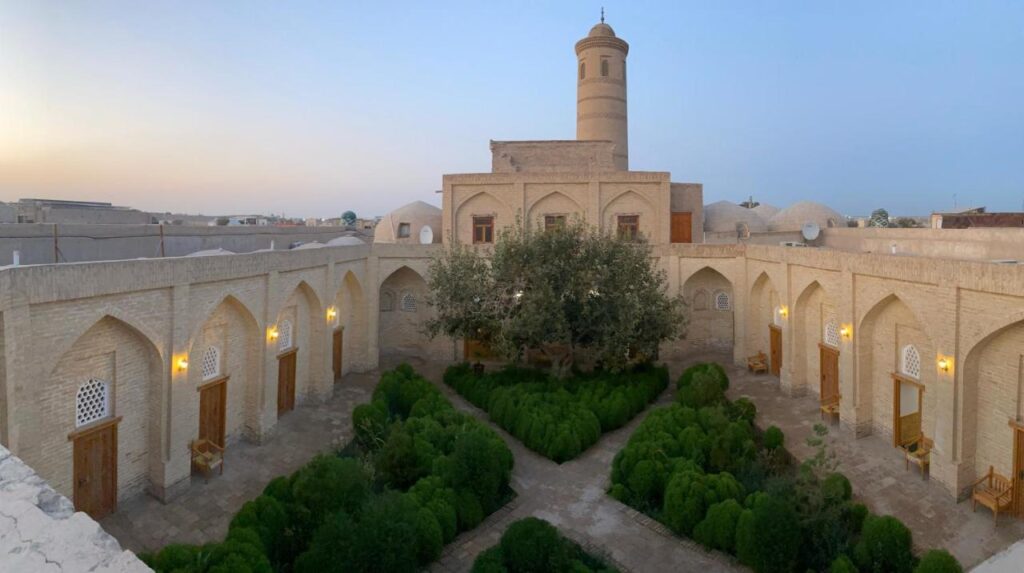
Located by the East gate of Itchan Kala, it’s a good choice for families as it has large rooms.
Khiva Luxury Hotels
For a luxury stay in Khiva, Farovon Khiva Hotel is the only 4 star hotel in the city and has the best facilities including an indoor swimming pool and gym. They also have an excellent breakfast to order that I can personally vouch for!
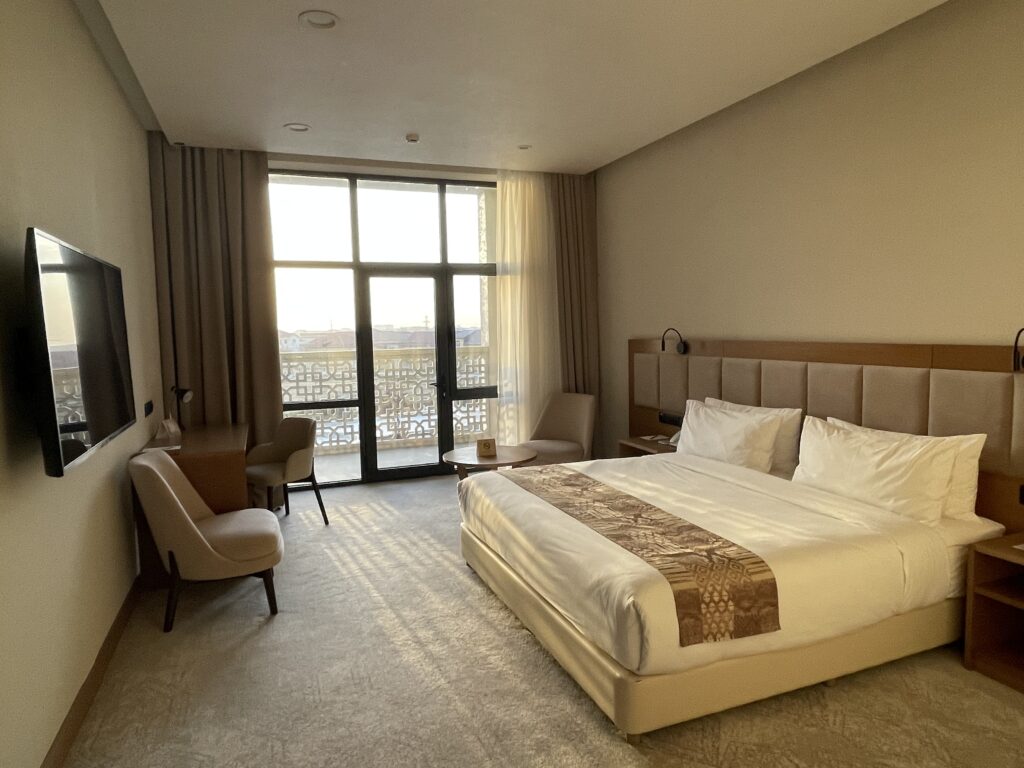
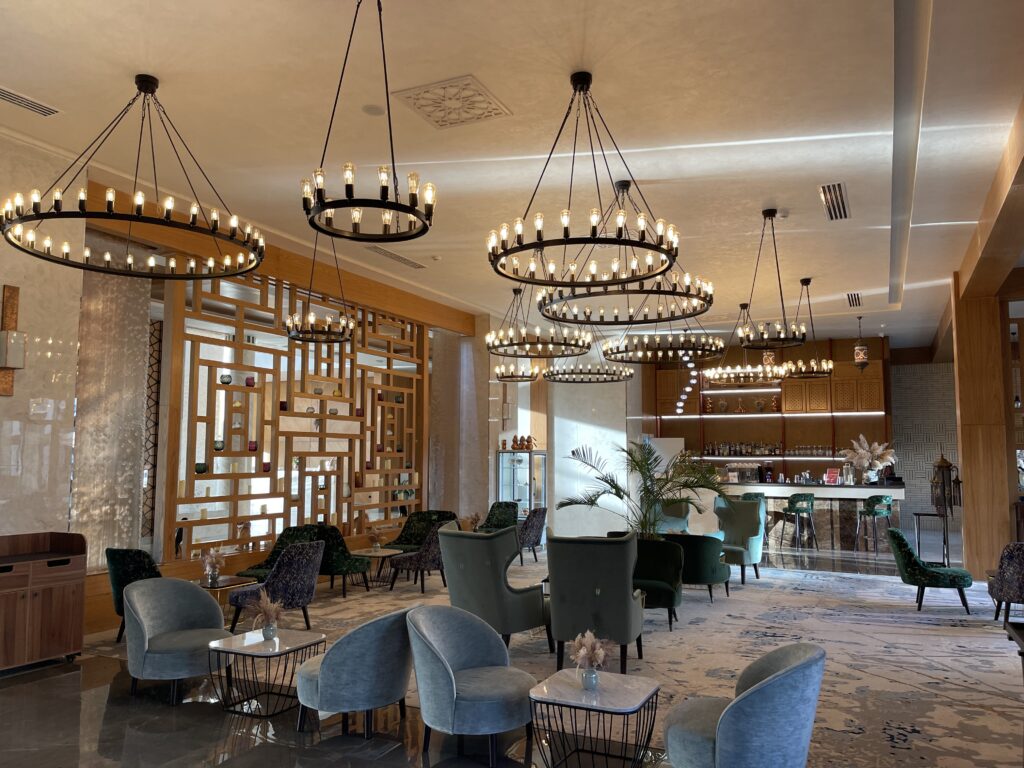
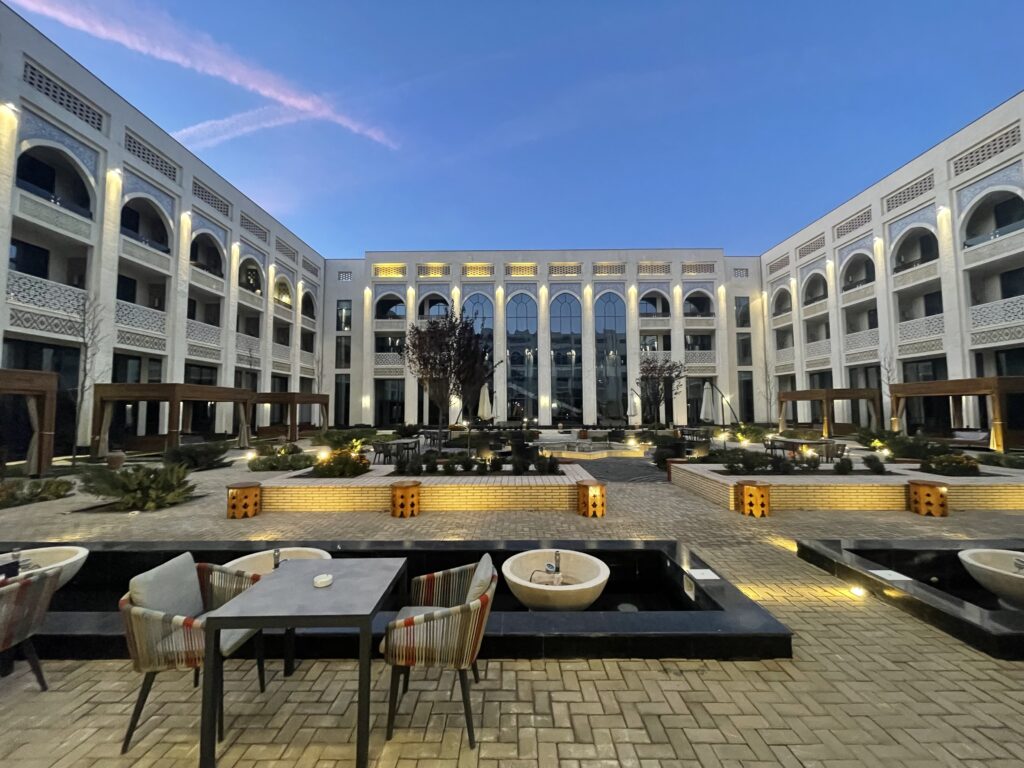
I stayed here myself on my first night and enjoyed wonderful service and a clean and comfortable room. The hotel is 3km from Itchan Kala and you can easily order a taxi from reception which takes just 5 minutes and costs around 15,000 Som (~$1.20).
Read more on the best areas to stay in Khiva.
What and Where to Eat in Khiva
Khiva Food
Khiva is a part of the Khorezm region of Uzbekistan and Khorezm food is quite distinct, including certain dishes that are only found in this region as well as other traditional Uzbek food like shashlik.
Tukhum Barak
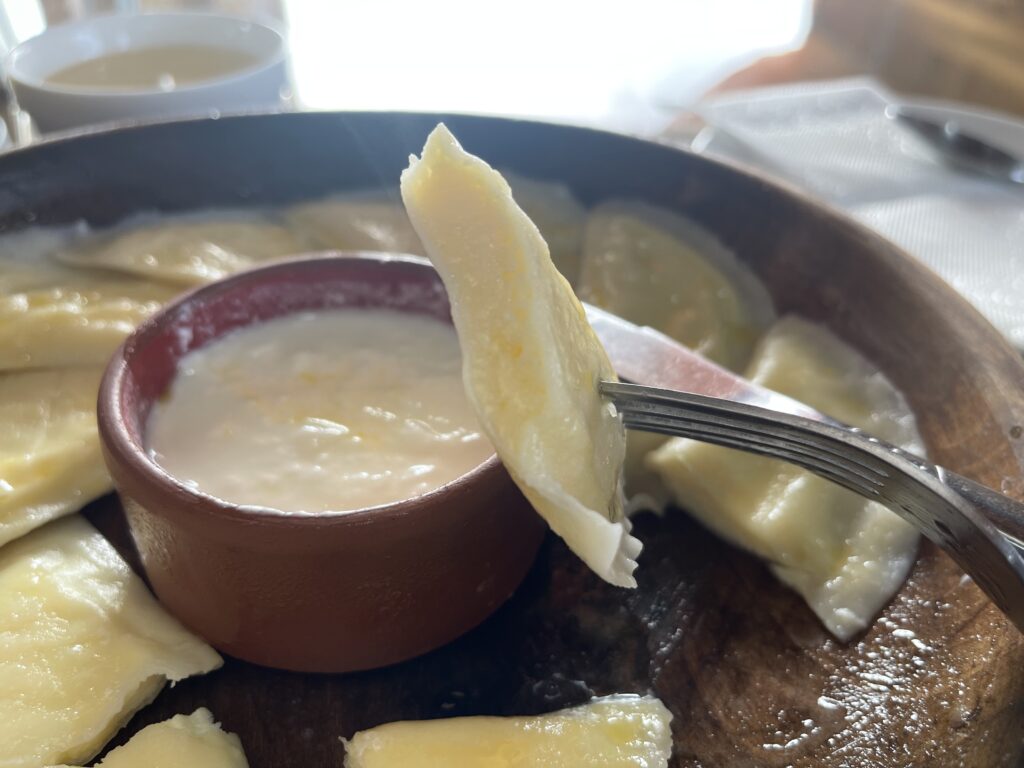
Tukhum Barak is made of dough and is similar in shape and texture to ravioli but is filled with egg. It is boiled for a short amount of time and served with sour cream.
Shivit Oshi
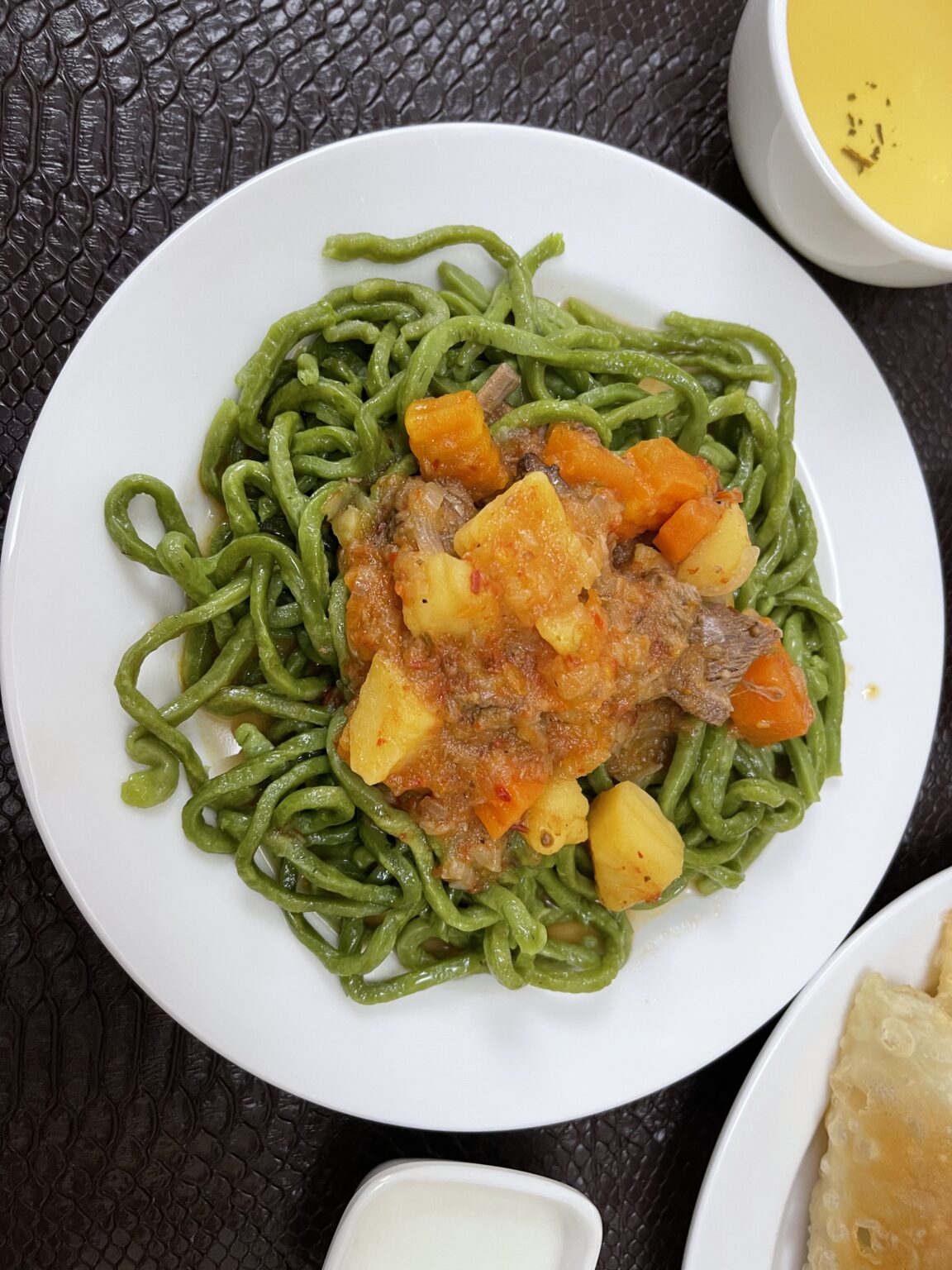
Shivit Oshi is a noodle dish considered to be Khiva’s version of lagman. Served with a meat and vegetable stew and sour milk, what makes this dish unique is the bright green color of its dill-infused noodles. This dish is perhaps the most intriguing dish for tourists and is definitely worth a try.
Gumma
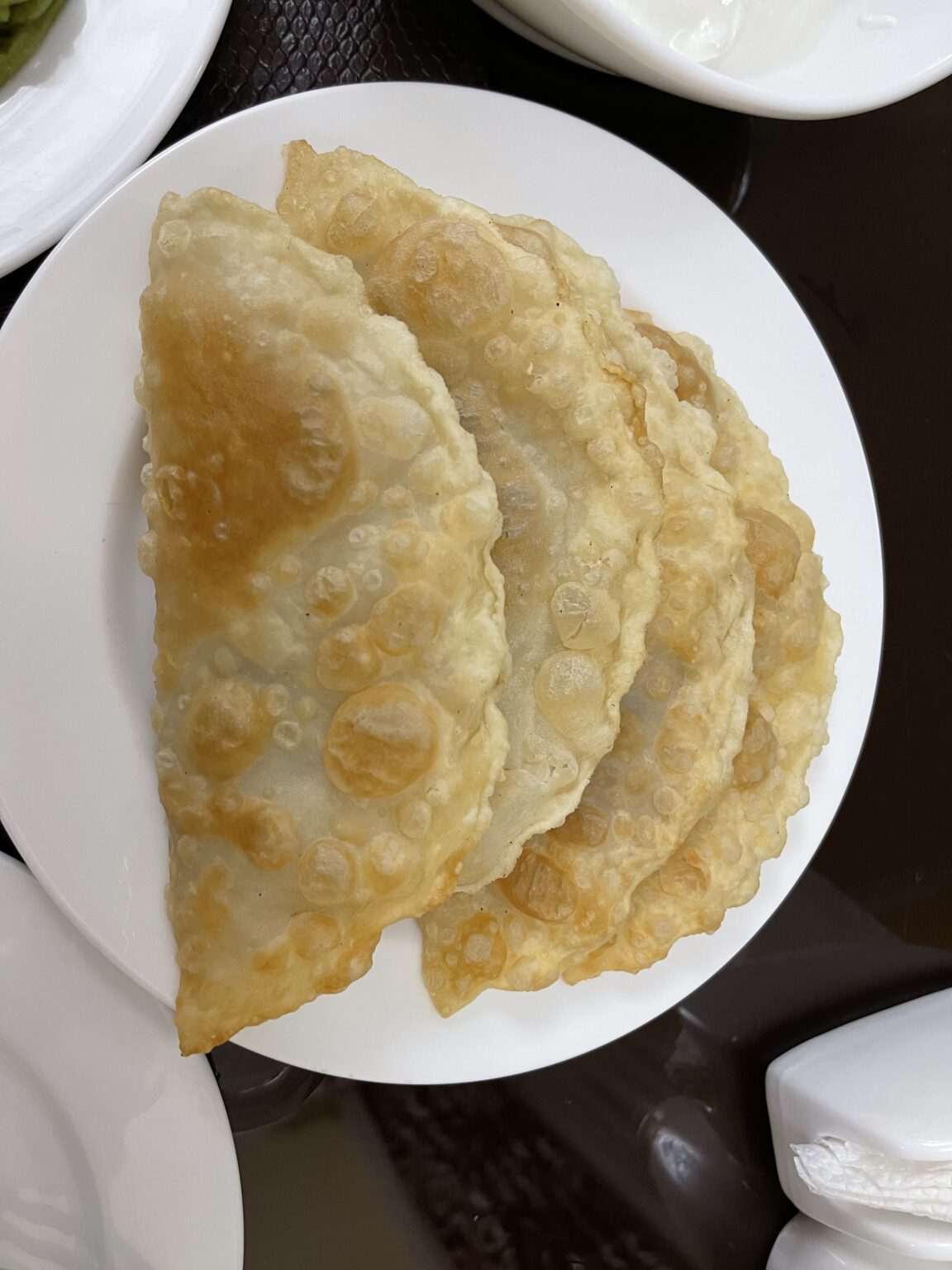
Gumma are fried crispy dumplings filled with either potato, spinach, ground beef, or pumpkin. They’re great for a snack when you’re in need of energy after roaming Khiva’s backstreets all morning!
Khorezm Plov
Each region of Uzbekistan prepares plov in a different way and what makes Khiva’s unique is that it contains little in the way of spices. Khorezm plov relies on the flavors of the main ingredients and uses yellow carrots, giving it a unique touch among Uzbekistan’s regional variations.
Best Restaurants in Khiva
Khiva boasts plenty of great-value hotels, yet its dining scene is a little limited due to space constraints. While not the best value compared to elsewhere in Uzbekistan, there are some great restaurants with friendly staff in unique settings.
Here are some of our top picks for restaurants in Khiva.
Terrassa Cafe & Restaurant
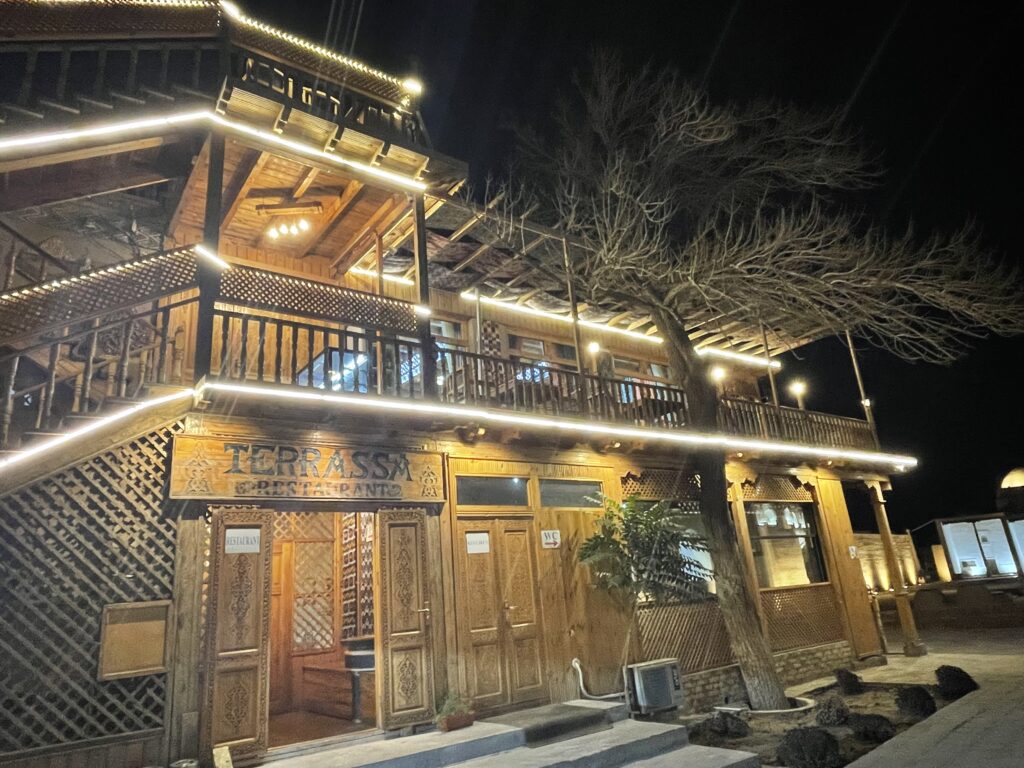
Terrassa is probably the most popular restaurant for tourists in Khiva owing to its central location, wide choice of traditional Uzbek food, and balcony and rooftop views of Itchan Kala.
Their rooftop has one of the best views of the city and is the perfect evening spot as the sun sets over the Kalta Minor Minaret.
If you’re not sure what to choose, their ‘Eight Tastes’ set menu for two has a mix of all local delights such as fried and steamed dumplings, shivit oshi, tukhum barak, gumma, and chicken and beef shashlik.
It’s also the best restaurant for vegans with a number of plant-based meals.
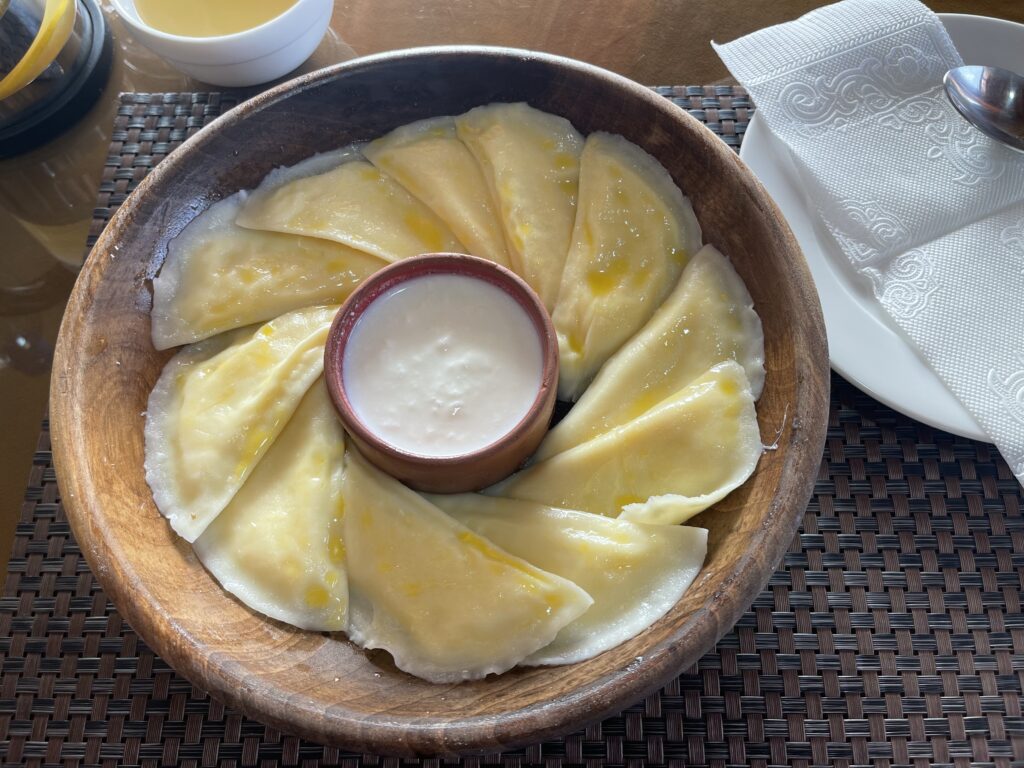
Khiva Moon
Located outside of Itchan Kala just a 5 minute walk from the West gate, Khiva Moon offers a cheaper alternative to the restaurants inside the old city.
With an extensive menu and attentive staff, what they lack in location they make up for in service. The courtyard setting in front of the building is a great setting for warm weather outdoor eating.
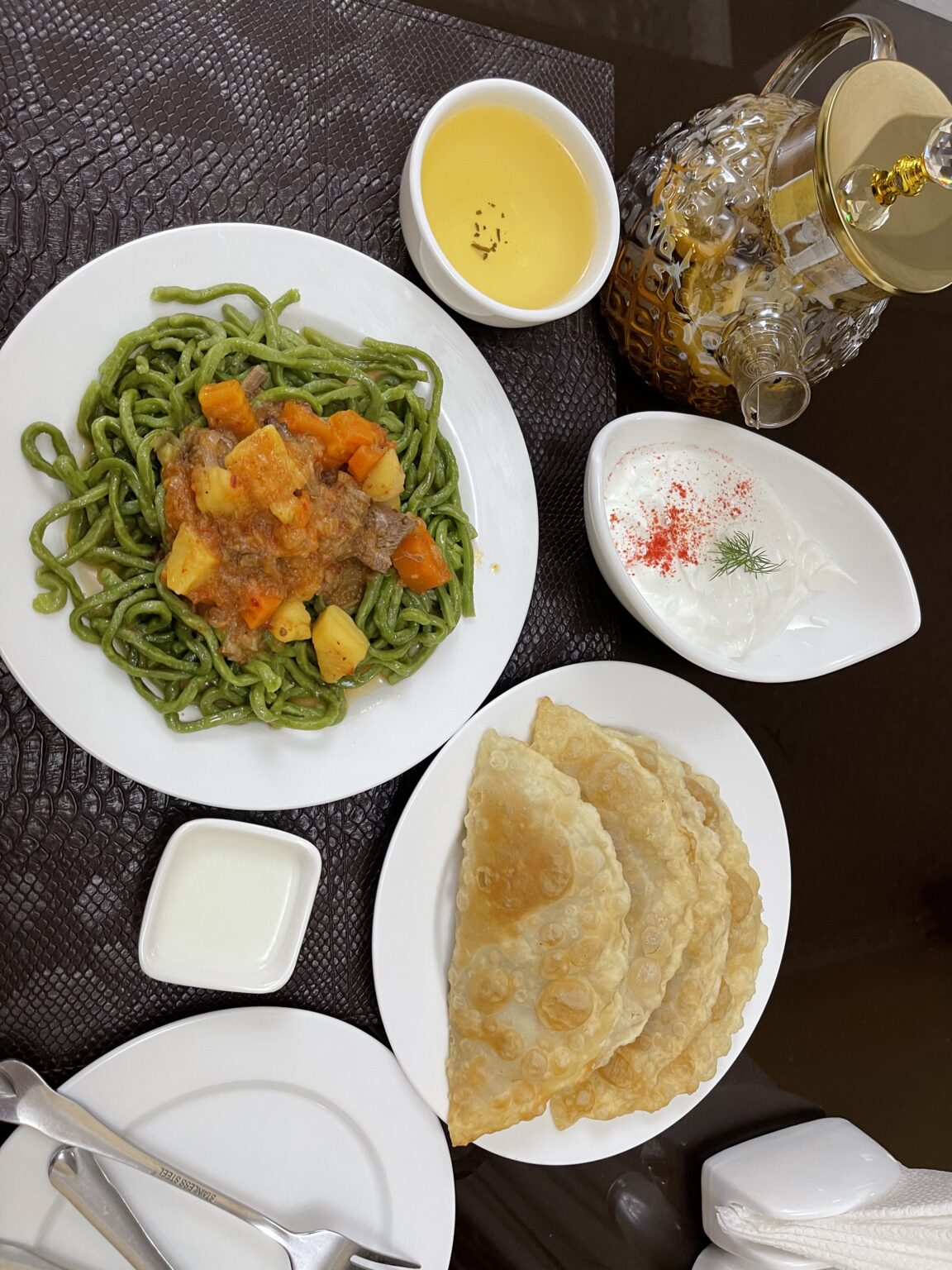
Cafe Zarafshon
The most beautifully decorated restaurant in Khiva, Cafe Zarafshon has wooden beams, yellow brick archways, wall-mounted porcelain, and a wooden wheel chandelier.
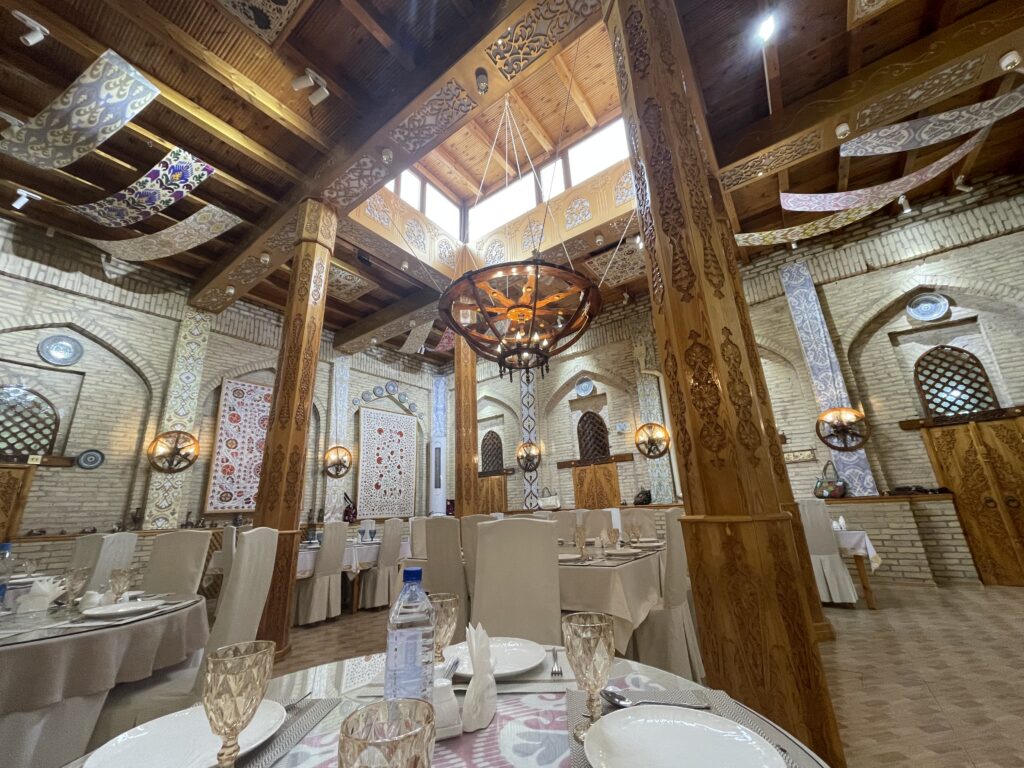
A great spot for lunch as there are many light meals on the menu such as salads, soups, and Uzbek side dishes such as dumplings and somsa. Also good for vegans and vegetarians.
Read more about the best restaurants in Khiva.
Related Guides:
Khiva Tours
With so many tourist attractions in such a compact area, the Itchan Kala fortress is the perfect spot for a day tour in Khiva.
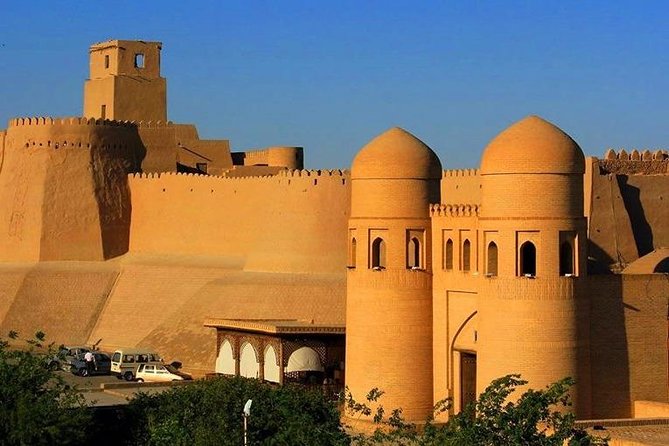
This top-rated tour of Khiva shows you around all of the sights of the city including the Kalta Minor, the Kunya Ark, Juma Mosque, Tosh Hovli Palace, Islam Khoja Minaret and much more.
Includes expert local guide and pick up from train station or airport.
“Excellent tour with an informed guide who clearly is interested in members of her tour guide and their interests.” – Read more reviews…
Read more about Khiva tours and day trips here.
Things to Know Before Visiting Khiva
Is Khiva Worth Visiting?
Khiva is well worth a visit providing you have time to do so. Being slightly less accessible than the alternative cities of Samarkand and Bukhara, it may be more convenient to visit these cities but if you have time to visit Khiva too then you won’t be disappointed.
Itchan Kala is very compact and boasts 51 ancient monumental structures in just a tiny space, showcasing the evolution of Islamic architecture over the centuries.
It’s a very affordable UNESCO World Heritage Site which is likely to grow in popularity over the next few years so visiting now before it gets busier is advisable.
How Many Days to Spend in Khiva
As Itchan Kala is such a small area, two days are enough to comfortably visit Khiva. It’s possible to visit Khiva in only one day but you’ll have to rush your way through the landmarks and it’s unlikely you’ll manage to visit them all.
If you have three or more days then you’ll also have time for a day tour from Khiva such as the ancient fortresses or even half a day at Urgench, a terribly unpopular yet charming unpolished Soviet-style city.
When to Visit Khiva
The peak season for visiting Khiva is the spring months of April and May or autumn months of September and October as the weather during these months is generally sunny, dry and warm but not too hot. Bear in mind however that these are the busiest months in what can be a densely packed area for tourists.
Summer can be uncomfortably hot in Uzbekistan so July and August are not recommended. If you can handle the cold then the beginning or end of winter can be a wonderful time to visit as there are so few tourists around and hotels are especially cheap this time of year.
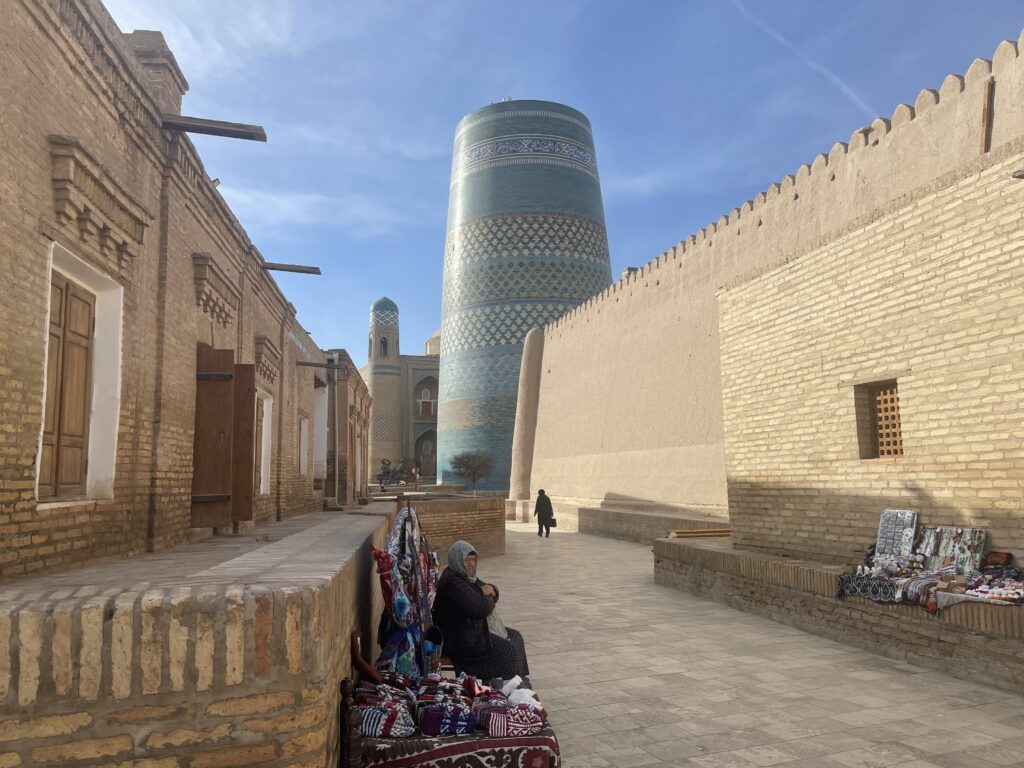
I personally visited at the start of December, securing a room in a 4 star hotel for $60 per night as well as enjoying deserted streets at night.
Ultimately it’s up to you whether to visit during the peak busier times or to accept slightly less favorable weather conditions for quieter streets.
Is Khiva Safe?
Overall, Uzbekistan is considered a very safe country to visit, often featured on the green lists of various government foreign travel advisory websites, including those of the US and UK.
As one of Uzbekistan’s main tourist cities, Khiva is particularly safe to visit. There are many mini tourist police stations around Khiva’s Itchan Kala, making it easy to contact police should you need to.
Read more about safety in Uzbekistan.
Money in Khiva
Many larger hotels and restaurants accept payment by international card but not all of them. There are a small number of ATMs inside and outside Itchan Kala; one is by the West gate. Orient Star Khiva hotel also has a currency exchange.
How to Get to Khiva
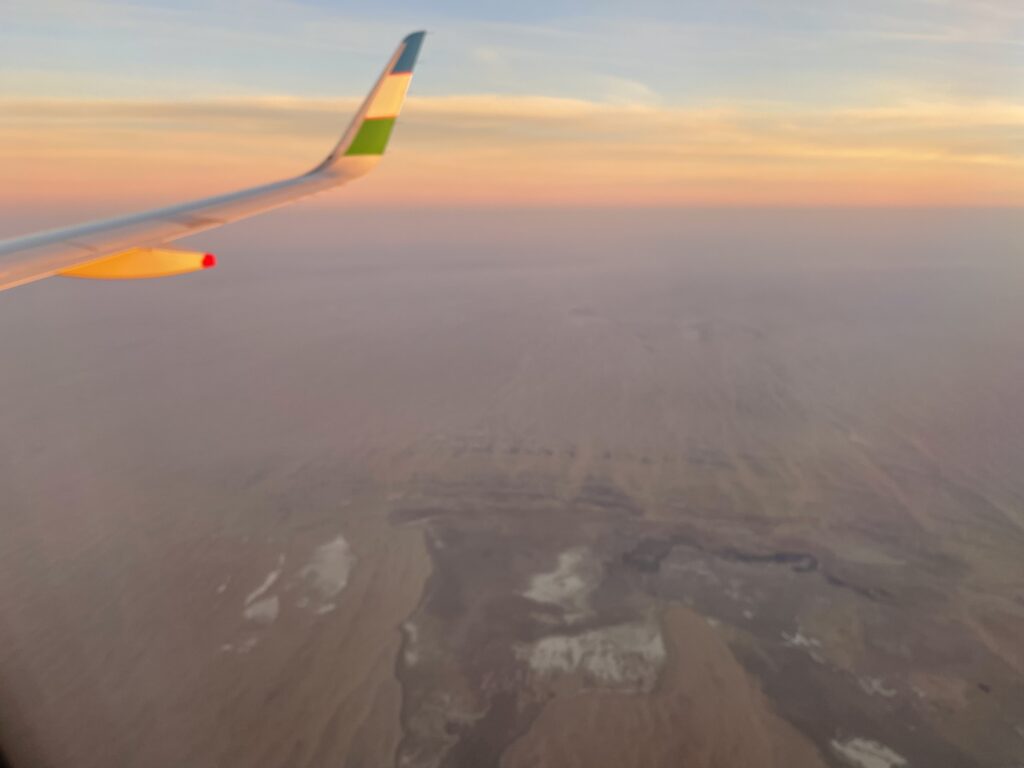
From Tashkent:
The most convenient way is to fly from Tashkent to Urgench and then take either the trolley bus or a private taxi from outside the airport to Khiva. The flight takes roughly 1 hour, 30 mins and the drive takes around 45 minutes. Flights to Khiva can be booked directly with Uz Airways.
At the time of my visit in December, there was no trolley bus, so a taxi was the only option. Rates are negotiable; I paid $10, although they may ask for more. You can book a taxi in advance via most hotels or booked in advance here.
For a full day guided tour of Khiva including flights and taxi pickup to and from Tashkent check out this tour.
Failing this overnight sleeper trains run twice a day taking around 14 hours. If you have time to travel this way it can be a fun experience. Train tickets can be bought from the official website or the more user-friendly 12Go website. The train station is just a 5 minute taxi or a 20 minute walk to the East gate.
It’s possible to travel by bus but we don’t recommend it as it’s roughly a 17 hour journey but it is the cheapest way. Bus tickets can be bought here.
From Samarkand:
You can fly from Samarkand to Urgench but flights are irregular and only once or twice a week. The best option is to take the overnight sleeper train which takes roughly 10 hours and leaves in the evening once or twice a day. Book on the official website or 12Go.
It’s also possible to travel by shared taxi. Ask at your hotel for up to date information.
From Bukhara:
Traveling between Bukhara and Khiva is perhaps the most difficult journey despite it being the closest. There are no flights between Bukhara and Khiva so the train is your best option. Night trains leave once or twice a day and the journey is around 6 hours, 30 mins. Book on the official website or 12Go.
It’s also possible to travel by shared taxi which should take around 6 or 7 hours depending on the ‘skills’ of your driver. Ask at your hotel for up to date information.
What to Wear in Khiva
There are no laws on what to wear in Uzbekistan but visitors should be mindful of the conservative culture of Khiva, particularly when visiting religious sites.
It’s advisable for both men and women to cover their shoulders and knees and for women to wear a headscarf when visiting religious sites. Headscarves aren’t necessary for entering Itchan Kala itself but only when entering the mosques and mausoleums etc.
As the weather can be hot, light clothing is recommended if visiting in the warmer months but bear in mind winter temperatures in Khiva can easily drop to less than -10°C/14°F.
Itchan Kala Entry Fee
There are different levels of tickets to enter Itchan Kala, and each ticket is valid for two days. A standard ticket grants entry to most museums and heritage sites, except for the ones listed below.
| Ticket | Price |
|---|---|
| Adult | 150,000 Som/$12 |
| Child | 75,000 Som/$6 |
| Diplomat | 75,000 Som/$6 |
| Diplomat Child | 40,000 Som/$3 |
| Islam Khoja Minaret | 100,000 Som/$8 |
| City Walls | 20,000 Som/$1.60 |
| Pahlavan Mahmud Mausoleum | 25,000 Som/$2 |
Note: Entrance to Itchan Kala can be a little confusing as there are a number of gates, some of which have ticket turnstiles and some which do not. It might also be possible to buy a cheaper ticket for 50,000 Som which allows entry to the city but not to any of the monuments but this was not advertised.
Khiva Travel Guide Summary
Khiva, an ancient Silk Road city, flaunts Itchan Kala, a UNESCO site with 50 stunning structures. From a Zoroastrian center to Islamic prominence, it’s a blend of history and modern life.
Affordable entry, diverse monuments, and rich heritage make it a captivating medieval fortress.
Hopefully this guide answers your questions about visiting Khiva. Safe travels!
Planning a trip to Khiva? Read our complete guide to travel in Uzbekistan.
